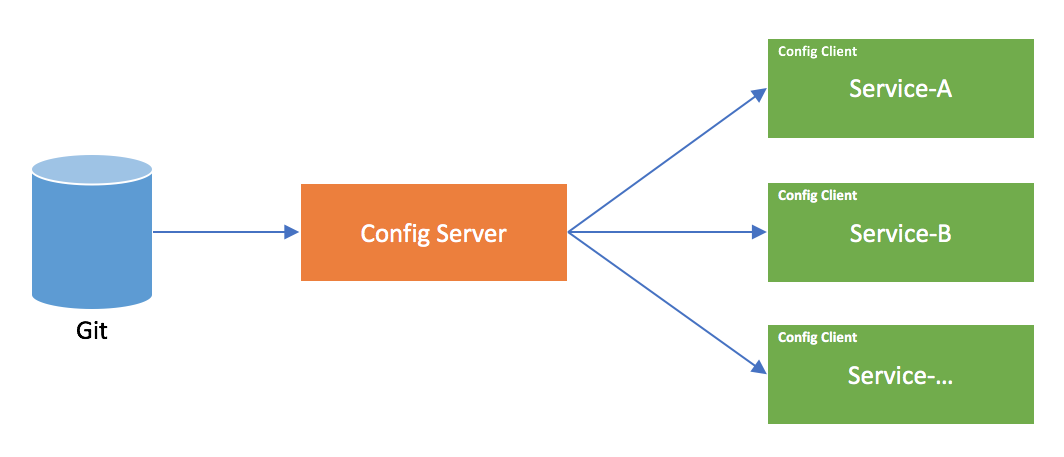SpringCloud笔记:统一配置中心入门。
对于配置的重要性,我想我不用进行任何强调,大家都可以明白其重要性。在普通单体应用,我们常使用配置文件(application(*).properties(yml))管理应用的所有配置。这些配置文件在单体应用中非常胜任其角色,并没有让我们感觉到有头疼的地方。但随着微服务框架的引入,微服务数量就会在我们产品中不断增加,之前我们重点考虑的是系统的可伸缩、可扩展性好,但随之就是配置管理的问题就会一一暴露出来。起初微服务器各自管各自的配置,在开发阶段并没什么问题,但到了生产环境管理就会很头疼,如果要大规模更新某项配置,困难就可想而知。
为此,在分布式系统中,Spring Cloud提供一个Config子项目,该项目核心就是配置中心,通过一个服务端和多个客户端实现配置服务。我们可使用配置服务器集中的管理所有服务的各种环境配置文件。配置服务中心默认采用Git的方式进行存储,因此我们很容易部署修改,并可以对环境配置进行版本管理。
Spring Cloud Config特点
Spring Cloud Config具有中心化、版本控制、支持动态更新和语言独立等特性。其特点是:
- 提供服务端和客户端支持(Spring Cloud Config Server和Spring Cloud Config Client);
- 集中式管理分布式环境下的应用配置;
- 基于Spring环境,实现了与Spring应用无缝集成;
- 可用于任何语言开发的程序;
- 默认实现基于Git仓库(也支持SVN),从而可以进行配置的版本管理;
Spring Cloud Config结构图

从图中可以看出Spring Cloud Config有两个角色(类似Eureka): Server和Client。Spring Cloud Config Server作为配置中心的服务端承担如下作用:
- 拉取配置时更新Git仓库副本,保证是配置为最新;
- 支持从yml、json、properties等文件加载配置;
- 配合Eureke可实现服务发现,配合Cloud Bus(这个后面我们在详细说明)可实现配置推送更新;
- 默认配置存储基于Git仓库(可以切换为SVN),从而支持配置的版本管理.
- 而对于,Spring Cloud Config Client则非常方便,只需要在启动配置文件中增加使用Config Server上哪个配置文件即可。
示例代码
构建Config-Server
编写pom.xml文件
Config-Server是一个标准的Spring Boot应用,所以pom.xml也是继承之前的Parent:
1 | <parent> |
编写启动类
1 | /** |
这里最重要的就是增加@EnableConfigServer,其它与之前的应用一致。
编写配置文件
1 | server.port=8280 |
这里最重要的是需要配置Git仓库的地址及登录用户名和口令。
创建测试配置文件
我们在SpringcloudSamplesConfig仓库中增加量个配置文件。
mallWeb.properties,文件内容如下:
1 | foo = bar |
mallWeb-dev.properties,文件内容如下:
1 | bar = cd826 |
注意:这里编写文件后记得提交,否则会测试失败。
启动测试
启动config-server. 在终端中我们输入以下命令(或者使用postman):
1 | curl localhost:8280/mallWeb/dev |
在终端中会输出以下内容:
1 | { |
这里可以看到,我们提交到Git中的配置文件已经能够被config-server正确的读取到。
config-server默认配置
当我们查看源码会发现在spring-cloud-config-server.jar包中有一个默认配置文件configserver.yml配置文件,也就是说当我们设置spring.application.name=configserver时,就会默认加载该配置文件,该配置文件内容如下:
1 | info: |
默认使用8888端口,并且从https://github.com/spring-cloud-samples/config-repo这个Git仓库中查找配置文件。
因为,在上面的示例中我们重新定义了应用名称和服务端口。
构建config-client
config-client可以是任何一个基于Spring boot的应用,这里为了讲解方便,我们构建一个非常简单的web工程。
编写pom.xml文件
我们的config-client项目需要引入对spring-cloud-starter-config的依赖,如下:
1 | <parent> |
编写启动类
一个标准的Spring Boot启动类:
1 | /** |
编写测试Controller
这个测试Controller主要就是验证我们可以从Git仓库中获取配置内容。
1 | /** |
编写配置文件
这里编写的配置文件名称为:bootstrap.properties,内容如下:
1 | server.port=8080 |
定义了微服务的名称和profile以及配置服务器的地址。
注意: 这些配置不能够配置在application.properties文件中,因为在Spring Boot启动时有引导上下文和应用上下文的概念,只有将配置服务器信息定义在引导上下文中,才能够从配置服务器中获取到配置信息。否则,服务启动时会报找不到foo变量定义的错误。
启动测试
启动后我们可以访问:http://localhost:8080/cfg/foo,可以看到如下界面:
Config-010
说明,我们的config-client已经成功从config-server上获取到配置的数据了。
Spring项目配置加载顺序
- 这里是列表文本命令行参数
- SPRING_APPLICATION_JSON 参数
- 从java:comp/env 加载 JNDI 属性
- Java系统属性 (System.getProperties())
- 操作系统环境变量
- 如果有使用 random.* 属性配置,则使用 RandomValuePropertySource 产生
- 外部特定应用配置文件 例如:application-{profile}.properties 或者 YAML variants
- 内部特定应用配置文件 例如:application-{profile}.properties 或者 YAML variants
- 外部应用配置文件 例如:application.properties 或者 YAML variants
- 内部应用配置文件 例如:application.properties 或者 YAML variants
- 加载@Configuration类的 @PropertySource 或者 @ConfigurationProperties 指向的配置文件
- 默认配置,通过SpringApplication.setDefaultProperties 设置
配置规则详解
下面我们来看一看Config Client从Config Server中获取配置数据的流程:
- Config Client启动时,根据bootstrap.properties中配置的应用名称(application)、环境名(profile)和分支名(label),向Config Server请求获取配置数据;
- Config Server根据Config Client的请求及配置,从Git仓库(这里以Git为例)中查找符合的配置文件;
- Config Server将匹配到的Git仓库拉取到本地,并建立本地缓存;
- Config Server创建Spring的ApplicationContext实例,并根据拉取的配置文件,填充配置信息,然后将该配置信息返回给Config Client;
- Config Client获取到Config Server返回的配置数据后,将这些配置数据加载到自己的上下文中。同时,因为这些配置数据的优先级高于本地Jar包中的配置,因此将不再加载本地的配置。
那么,Config Server又是如何与Git仓库中的配置文件进行匹配的呢?通常,我们会为一个项目建立类似如下的配置文件:
1 | mallweb.properties: 基础配置文件; |
当我们访问Config Server的端点时,就会按照如下映射关系来匹配相应的配置文件:
1 | /{application}/{profile}[/{label}] |
而Config-Client的bootstrap.properties配置对应如下:
1 | spring.application.name <==> application; |
2.1 Git仓库配置
Config Server默认使用的就是Git,所以配置也非常简单,如上面的配置
1 | (application.properties): |
那么客户端在请求时服务端就会到该仓库中进行查找。
2.1.1 使用占位符
在服务端配置中我们也可以使用{application}、{profile} 和 {label}占位符,如下:
spring.cloud.config.server.git.uri=http://github.com/cd826/{application}
spring.cloud.config.server.git.username=username
spring.cloud.config.server.git.password=password
这样,我们就可以为每一个应用客户端创建一个单独的仓库。
这里需要注意的是,如果Git的分支或标签中包含”/“时,在{label}参数中需要使用”(_)”替代,这个主要是避免与Http URL转义符处理的冲突。
2.1.2 使用模式匹配
我们也可以使用{application}/{profile}进行模式匹配,以便获取到相应的配置文件。配置示例如下:
spring.cloud.config.server.git.uri=https://github.com/spring-cloud-samples/config-repo
spring.cloud.config.server.git.repos.simple=https://github.com/simple/config-repo
spring.cloud.config.server.git.repos.special.pattern=special*/dev*,special/dev*
spring.cloud.config.server.git.repos.special.uri=https://github.com/special/config-repo
spring.cloud.config.server.git.repos.local.pattern=local*
spring.cloud.config.server.git.repos.local.uri=file:/home/configsvc/config-repo
如果模式中需要配置多个值,那么可以使用逗号分隔。
如果{application}/{profile}没有匹配到任何资源,则使用spring.cloud.config.server.git.uri配置的默认URI。
当我们使用yml类型的文件进行配置时,如果模式属性是一个YAML数组,也可以使用YAML数组格式来定义。这样可以设置成多个配个配置文件,如:
spring:
cloud:
config:
server:
git:
uri: https://github.com/spring-cloud-samples/config-repo
repos:
development:
pattern:
- */development
- */staging
uri: https://github.com/development/config-repo
staging:
pattern:
- */qa
- */production
uri: https://github.com/staging/config-repo
2.1.3 搜索目录
当我们把配置文件存放在Git仓库中子目录中时,可以通过设置serch-path来指定该目录。同样,serch-path也支持上面的占位符。示例如下:
spring.cloud.config.server.git.uri=https://github.com/spring-cloud-samples/config-repo
spring.cloud.config.server.git.searchPaths=foo,bar*
这样系统就会自动搜索foo的子目录,以及以bar开头的文件夹中的子目录。
2.1.4 SSH配置
如果你不想使用HTTPS和用户认证,也可以直接使用SSH,这时候我们只需要将ssh需要的keys存储在~/.ssh目录即可,并将所配置的uri指向SSH地址即可,如:git@github.com:cd826/SpringcloudSamplesConfig。
如果你清楚的知道你的~/.git目录,那么你可以使用git config –global来配置。否则可以使用全局配置,比如:git config –global http.sslVerify false。
2.1.4 代理
Config-Server会使用JGit访问配置库,因此我们可以在~/.git/config下配置HTTPS所使用的代理,也可以使用JVM系统属性-Dhttps.proxyHost和-Dhttps.proxyPort来配置。
2.1.5 本地缓存
当Config-Server从Git(或SVN)中获取了配置信息后,将会在本地的文件系统中存储一份。默认将存储在系统临时目录下,并且以config-repo-作为开头,在Linux系统中默认存储的目录为/tmp/config-repo-
17:18:01 285 [http-nio-8280-exec-1] WARN o.s.c.c.s.e.MultipleJGitEnvironmentRepository - Could not fetch remote for master remote: https://github.com/cd826/SpringcloudSamplesConfig
17:18:01 660 [http-nio-8280-exec-1] INFO o.s.c.a.AnnotationConfigApplicationContext - Refreshing
17:18:01 710 [http-nio-8280-exec-1] INFO o.s.b.f.a.AutowiredAnnotationBeanPostProcessor - JSR-330 ‘javax.inject.Inject’ annotation found and supported for autowiring
17:18:01 782 [http-nio-8280-exec-1] INFO o.s.c.c.s.e.NativeEnvironmentRepository - Adding property source: file:/Users/cd826/MyWork/springcloud-sample-projects/config/config-server/tmp/mallWeb-dev.properties
17:18:01 782 [http-nio-8280-exec-1] INFO o.s.c.c.s.e.NativeEnvironmentRepository - Adding property source: file:/Users/cd826/MyWork/springcloud-sample-projects/config/config-server/tmp/mallWeb.properties
Spring Cloud 官方文档建议我们在Config-Server中指定本地文件路径,以避免出现不可预知的错误。可以使用下面的属性配置来指定本地文件路径:
Git仓库
spring.cloud.config.server.git.basedir=tmp/
SVN仓库
spring.cloud.config.server.svn.basedir=tmp/
2.2 SVN配置
如果你的项目中使用的是SVN而不是Git,那么只需要在Config-Server中进行如下修改就可以支持SVN仓库。
2.2.1 修改pom.xml
在pom文件中增加以下依赖:
spring.profiles.active=native
注意Config-Server默认会从classpath下加载,我们可以使用spring.cloud.config.server.native.searchLocations属性来设置配置文件的目录。对于文件路径,我们的配置必须以file:开头,如果是Windows系统对于绝对路径我们还得对/进行转义,比如,在Windows下我们需要配置如下:file:///${user.home}/config-repo。
此外,当我们使用文件系统作为配置文件仓库时,spring.cloud.config.server.native.searchLocations的配置也是支持{application} 、{profile} 和 {label} 占位符的。
Spring Cloud 官方还是推荐在测试和开发的时候可以使用文件系统,但是在正式环境中尽量还是使用Git或者SVN。
另,Spring Cloud Config中还支持另外一种配置文件方式:Vault Server,这个后面有空我们再探讨。
- 安全保护
- 1 Config-Server访问安全
对于我们存储在配置中心的一些配置内容,总会有一些是敏感信息,比如数据库连接的用户名和密码,你总不能直接裸奔吧,所以我们还是需要对Config-Server做一些安全控制。当然,对于Config-Server的安全控制有很多种,比如:物理网络限制、OAuth2授权等。但是,在这里因为我们使用的是SpringBoot,所以使用SpringSecurity会更容易也更简单。这时候,我们只需要在Config-Server中增加如下依赖:
security.user.name=cd826
security.user.password=pwd
这样,当我们需要访问Config-Server时就会弹出用户认证对话框。此时,对于Config-Client我们需要在配置文件中增加用户和访问口令的配置,如下:
spring.cloud.config.username=cd826
spring.cloud.config.password=pwd
3.2 加密与解密
访问安全是对整体的控制,多数情况下我们还需要对敏感内容加密后存储,比如之前所说的数据库访问的用户名称和登录口令。很幸运,Spring Cloud Config为我们提供相应的支持。
Spring Cloud Config提供了两种加解密方式: 1)对称加密; 2)非对称加密。在描述如何使用之前,我们先看看一些使用前提。
3.2.1 安装JCE(Java Cryptography Extension)
Spring Cloud Config所提供的加解密依赖JCE,因为,JDK中没有默认提供,所以我们需要先安装JCE。安装方法也比较简单,就是下载相应的Jar包,然后把这些包替换$JDK_HOME/jar/lib/security相应的文件,对于JDK8下载地址为:JCE for JDK8.
3.2.2 加解密端点
另外,Spring Cloud Config还提供了两个端点进行加密和解密,如下:
/encrypt: 加密端点,使用格式如下: curl $CONFIG_SERVER/encrypt -d 所要加密的内容
/decrypt: 解密端点,使用格式如下: curl $CONFIG_SERVER/decrypt -d 所要解密的内容
注意:当你测试中所加解密中包含特殊字符时,需要进行URL编码,这时候你需要使用–data-urlencode而不是-d.
3.2.3 对称加密
对称加解密的配置非常简单。我们只需要在配置文件中增加加解密所使用的密钥即可,如:
encrypt.key=cd826_key
配置好之后,你可以启动Config-Server,并使用上面所说的端点进行加解密测试。
对于,配置文件我们需要为加密的内容增加一个{cipher}前导符。如:
spring.datasource.username=dbuser
spring.datasource.password={cipher}FKSAJDFGYOS8F7GLHAKERGFHLSAJ
但是,如果你使用的配置文件是yml格式,那么需要使用单引号把加密内容引起来,如下:
spring:
datasource:
username:dbuser
password:’{cipher}FKSAJDFGYOS8F7GLHAKERGFHLSAJ’
3.2.4 非对称加密
非对称加密相对于对称加密来说复杂了一些,首先我们需要借助Java的keytool生成密钥对,然后创建Key Store并复制到服务器目录下。对于keytool的使用可以参考这里:《Spring Cloud入门教程(番外篇四): Keytool证书工具》。
使用keytool生成Key Store,命令如下:
$ keytool -genkeypair -alias tsfjckey -keyalg RSA
-dname “CN=Mall Web,OU=TwoStepsFromJava,O=Organization,L=city,S=province,C=china” \
-keypass javatwostepsfrom -keystore server.jks -storepass twostepsfromjava
将所生成server.jks拷贝到项目的resources目录下(Config-Server)。
修改配置文件:
encrypt.key-store.location=server.jks
encrypt.key-store.alias=tsfjckey
encrypt.key-store.password=twostepsfromjava
encrypt.key-store.secret=javatwostepsfrom
非对称加密相对于对称加密来说配置也复杂,但安全性也会高很多。
3.2.5 使用多个加密Key
也许,我们需要对不同的敏感信息使用不同的加密key,这时候我们的配置文件只需要按如下进行编写:
foo.bar={cipher}{key:testkey}…
Config-Server在解密的时候就会尝试从配置文件中获取testkey的做为密钥。
- 高可用配置
- 1 整合Eureka
看到这里,可能有些童鞋已经发现,我们在Config-Client中配置config.uri时使用的具体的地址,那么是否可以使用之前的Eureka呢?答案是肯定,我们可以把Config-Server和其它微服务一样作为一个服务基本单元。我们只需要进行如下修改即可。
4.1.1 Config-Server改造
在pom.xml中增加如下依赖:
spring.application.name=config-server
eureka.client.service-url.defaultZone=http://localhost:8260/eureka
启动类:
/**
TwoStepsFromJava Cloud – Config Server
@author CD826(CD826Dong@gmail.com)
@since 1.0.0
/
@SpringBootApplication
@EnableConfigServer
@EnableDiscoveryClient
public class Application {public static void main(String[] args) {
SpringApplication.run(Application.class, args);}
}
增加@EnableDiscoveryClient注解。
Ok,到这里为止,Config-Server修改已经完成。如果我们启动Config-Server就会在Eureka服务器上看到相应的服务注册。
4.1.2 Config-Client改造
在pom.xml中增加如下依赖:
spring.application.name=mallWeb
spring.cloud.config.profile=dev
eureka.client.service-url.defaultZone=http://localhost:8260/eureka
spring.cloud.config.discovery.enabled=true
spring.cloud.config.discovery.service-id=config-server
修改启动类:
/**
TwoStepsFromJava Cloud – Config Client Project
@author CD826(CD826Dong@gmail.com)
@since 1.0.0
/
@EnableDiscoveryClient
@SpringBootApplication
public class Application {public static void main(String[] args) {
SpringApplication.run(Application.class, args);}
}
这样就完成了从Eureka中获取Config-Server的服务信息。
这里最重要的就是在配置中增加: spring.cloud.config.discovery.enabled=true,并将原来所配置的spring.cloud.config.uri,修改为spring.cloud.config.discovery.service-id。
4.2 快速失败与响应
4.2.1 开启Config-Server启动加载
默认情况下,只有当客户端请求时服务端才会从配置的Git仓库中进行加载,我们可以通过设置clone-on-start,让服务端在启动时就会加载。
spring.cloud.config.server.git.uri=https://git/common/config-repo.git
spring.cloud.config.server.git.repos.team-a.pattern=team-a-*
spring.cloud.config.server.git.repos.team-a.clone-on-start=true
spring.cloud.config.server.git.repos.team-a.uri=http://git/team-a/config-repo.git
spring.cloud.config.server.git.repos.team-b.pattern=team-b-*
spring.cloud.config.server.git.repos.team-b.clone-on-start=false
spring.cloud.config.server.git.repos.team-b.uri=http://git/team-b/config-repo.git
spring.cloud.config.server.git.repos.team-c.pattern=team-c-*
spring.cloud.config.server.git.repos.team-c.uri=http://git/team-a/config-repo.git
上面的配置,对于team-a的则在Config-Server启动时就会加载相应的配置,而对于其它则不会。当然,我们可以通过设置spring.cloud.config.server.git.clone-on-start的值来进行全局配置。
4.2.2 开启Config-Client快速失败
在一些情况下,我们希望启动一个服务时无法连接到服务端能够快速返回失败,那么可以通过下面的配置来设置:
spring.cloud.config.fail-fast=true
4.2.3 设置Config-Client重试
如果在启动时Config-Server碰巧不可以使用,你还想后面再进行重试,那么我们开始开启Config-Client的重试机制。首先,我们需要配置:
spring.cloud.config.fail-fast=true
然后,我们需要在我们的的依赖中增加:
如果你想全权控制重试机制,可以实现一个类型为:RetryOperationsInterceptor的类,并把bean的id设置为:configServerRetryInterceptor。
4.3 动态刷新配置
Config-Client中提供了一个refresh端点来实现配置文件的刷新。要想使用该功能,我们需要在Config-Client的pom.xml文件中增加以下依赖:
但是,最好的方式还是和Spring Cloud Bus进行整合,这样才能实现配置的自动分发,而不是需要手工去刷新配置。